Text
When you see yourself in trash (Gachiakuta Discussion)
So with the positive reception of my recent thinkpiece, I wanted to make good on my promise that I’d post more. And this has kinda been one I’ve been wanting to do for a while. But due to the deeply personal nature of it, I wanted to really give it the time it deserved to come together.
This is going to be a post about Gachiakuta, which if my multiple posts on it haven’t been an indicator, I'm kinda a big fan. But what’s more, I really wanted to talk about why Gachiakuta speaks to me more in depth.

Background
So for those who don’t know, Gachiakuta is a weekly manga series by mangaka Kei Urana. Urana is a former assistant of the student of the Soul Eater and Fire Force creator, Atsushi Okubo. This series premiered shortly after Okubo’s Fire Force finished up, and stars a young boy named Rudo who lives in the slum area of a place called “The Sphere” (Or Heaven depending on the translation). Rudo has a habit of stealing from waste deposit sites and repairing broken items he finds. He lives with his adopted father Regeto after his biological father was sentenced to “The Abyss” for murder. The Abyss is a gaping chasm where all of the Sphere’s trash and prisoners are dumped.
Rudo is a somewhat surly child, and noticeably struggles with properly expressing his emotions despite the fact he is a highly emotional person. Smiling in particular is a struggle for him. Rudo one day comes to find Regto killed by a mysterious masked man, and blamed for this crime. Rudo is sentenced to the Abyss where he cries in anger he will return and kill everyone here. In the Abyss, Rudo is met by monsters made of trash and people devoted to fighting them, the Cleaners (Or Janitors depending on the translation). This fighting force of magic garbage men use the power of a “Giver” to empower items dear to them known as Jinki. With Rudo discovering that he can do the same with his gloves given to him by Regeto. Now he’ll work with the Cleaners killing trash monsters as he unravels the mystery of who killed his adoptive father and how he’ll escape the Abyss.

And it has been the newest manga series in the last four years that has not only made me feel hyped but await every chapter since its release.
Now if everything I said previously sounded like “well that sounds like a fairly straight forward if somewhat interestingly flavored revenge action manga. What makes it special?” Well then we’re going have to talk about Rudo.
Rudo
So Gachiakuta is a series with a lot of weirdos in it and some unconventional story structures to it (and we’ll touch on that later) but I think the character who embodies the core of this series is its MC, Rudo.
On the surface Rudo is a character that could feel at home with any number of shonen manga protags. Really expressive, yells a lot, spiky hair, and a power that’s kinda special amongst its power system. Basically, If Deku from MHA was a bit more angry and sleep deprived, you probably think he and Rudo were the same person on the surface. And for the most part, Rudo seemed to be that way, an angry kid out for revenge who treasured the last remaining gift he received from his foster father. Yet then we get to chapter 15 of Gachiakuta. A truly special chapter.
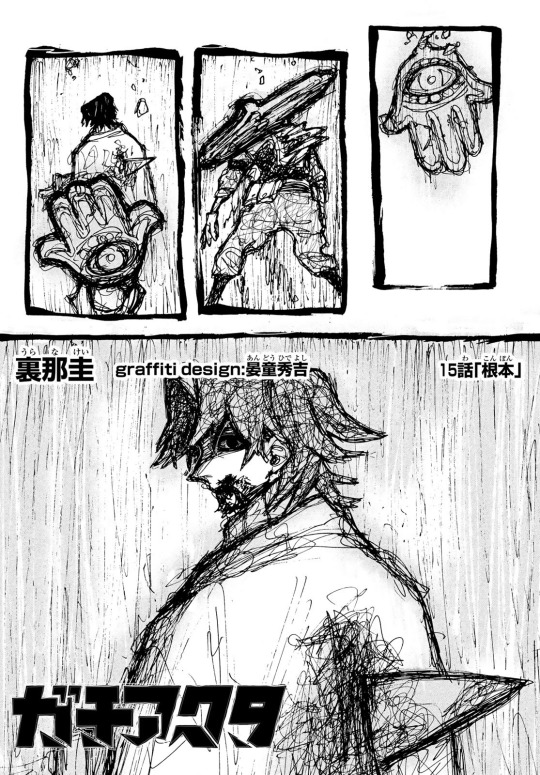
When Griss, Rudo’s teammate for this mission, was run through with claws by the villain, Jabber Wongar, Rudo seems to suffer some for of PTSD as the world goes hazy and he sees Griss as Regeto, stabbed and bleeding. We cut to Rudo as a child in Regto’s care and there, Rudo is banging his head against a wall to the point blood is coming out.
When Regto asks why Rudo would do this, the only thing Rudo can describe is how he has nothing. He has these feelings he doesn’t know how to describe yet he believes he’s nothing from the abuse he suffered at the hands of parents. All he has to really express it it this sort of frustration. While Rudo’s parents being murders may have been a lot for any child, Rudo carries literal scars given to him by his father. His hands peeled and scared and burnt black. The pain in his hands stops when he wears the gloves Regto gave him.

And when Regto wants Rudo to find something to focus his passion into, the thing that catches Rudo’s attention the most is a broken mannequin. Rudo cries letting out those feelings he said he couldn’t describe. Wanting to fix something and can’t believe it was tossed away because it was “a little broken.” At that moment, Regto realizes something about Rudo. He sees himself in those same objects that weren’t valued and tossed away.


So this is where I get to one of the things about Gachiakuta and Rudo in particular that speaks to me. Rudo, to me, is an example of a neurodivergent child and the text actually bothers to focus on how this affects his life. Now I know the moment I’ve said that there will be a lot of people who want me to explain, and the first thing is, no the manga doesn’t come out and say that Rudo is on the spectrum. But rather it lays a pretty explicit analogy to someone who may not be typical in some regard mentally or emotionally.
I know in the space of neurodivergent individuals representation is… difficult. Not just to find in the media, but also represented in a way that isn’t just “they’re a super genius.” Because there are many many forms of neurodivergence and how the manifest can be different for many individuals. Someone with ADHD may have their life affected in ways different than someone diagnosed with Autism. This is where I think it's very important for me to say, I’m just one guy on the spectrum. I’m speaking from my personal experience but you shouldn’t take my opinion as gospel. This is just me and my experiences. And my personal reading of this
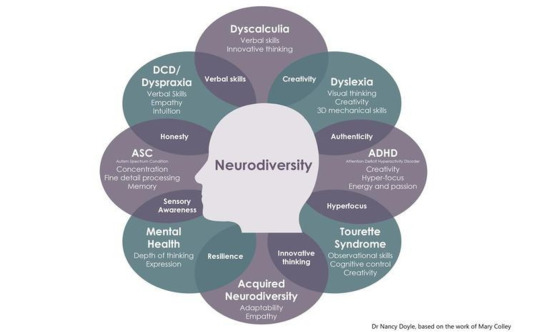
So when I say, a “mentally different character” in the media can be a tricky tightrope to walk, I mean it. Wanting there to be a positive representation for a community that may not get representation, but also not wanting to be like some monolithic depiction of what living with one of these conditions may be like. And there are plenty of ways where this could go very wrong (Anyone remember the time Aquaman cured Autism?). So when the text can’t just say “I am X” it's not uncommon for the readers to begin to see or relate to how a character may act. Speaking of how they act, in the case of anime and manga another “complication” can occur in the fact that many of these characters can act… well whacky and that’s treated as most acceptable in the universe. Whereas in real life, its likely anywhere from Gon to Goku would get side eye with their behavior. And thus you have the basis for plenty of head canons, one prominently being a character’s place on the spectrum.
Let's take any character, say Rill Boismortier from the series Black Clover. He’s a relatively second character in the series with an aptitude for art magic, who had locked himself in his room isolating himself from others till his butler reached him and now he’s a very eccentric, excitable, outgoing character. From the fact that he has a fixation on art to things like making sounds that could be read as vocal stimming, Rill could be read as an autistic character.
Or how about we look at one of the more memetic takes of the internet and all the jokes that Fern and Frieren from Frieren: Beyond the Journey’s End are autistic. This joke mainly comes from how in this world everything has a cool, somewhat mellow vibe with many people acting very muted. With Frieren herself struggling with making a distinction in the passage of time thanks to her elven aging and trying to understand the human condition. And Fern also a relatively reserved and subdued individual only really expresses her feeling a sensation of frustration or annoyance through “Kawaii pouting” puffing out her cheeks.

There are plenty more examples, but I wanted to illustrate that there are characters in manga and anime that I believe-yes, someone with neurodivergence could identify with, however, would I go as far as to say that this was the writer's original intention? Well choosing to err on the side of caution, I'm going to guess not likely. Someone could easily say, “you’re reading too much into it. There is nothing in the canon that outright says that. Rill is just a joke character, Frieren is a completely different species so it can’t really be neuro-atypical from a human standpoint, Fern’s pouting is just a gap moe trope.” And to be honest, I don’t necessarily think people holding these beliefs would be wrong. Nor do I wish to imply that if someone sees themselves in one of these characters that means they’re on the spectrum.
I'm saying there’s nothing wrong with either option. If you are someone neurodivergent and you see yourself in someone like Rill, that’s great. If you are someone who isn’t neurodivergent but still sees themselves in someone like Rill, that’s also great. The point I’m trying to make is that it may be unintentional, but a neurodivergent person seeing a neurodivergent story inside a specific character can happen and in many ways offer insights into the character.
And for someone like me who has spent a long time coming to grips with how my atypicality has affected my identity, Rudo’s story hit me. Hit me in a way I don’t think many series have. Rudo is a character who shows a fixation on trash, particularly broken pieces of trash. His old wounds he covers and just the feelings on this specific piece of clothing is able to make the feelings of his wounds go away. And just the way he described having emotion inside, but not being able to properly express it to the point he was doing self harm, it tore me up inside.
Made even more dramatic by the fact that Rudo is having this flashback being triggered by Griss being stabbed. Griss is a guy Rudo has known for a day who is shown to be a cool guy, but most importantly, when Rudo spent his welcome party sulking in a corner all tied up in his shell, only for Griss to ask him about his future. Rudo truly was feeling like he was losing a fatherly figure again in front of him
This was one of the moments that in my mind showed me the sort of direction this series wanted to go in with Rudo. Edgy, dark, cool, and stylistic revenge series in manga have existed for years. In fact, they’ll exist long after Gachiakuta and myself have expired. Many of these series can vary on the portrayal of their MC, conflicted, ready to embrace destruction, righteous in their pursuit, yet Gachiakuta has been unique for me, seeing Rudo have all the hallmarks for a vengeful story yet people always come to speak with him on his behavior.
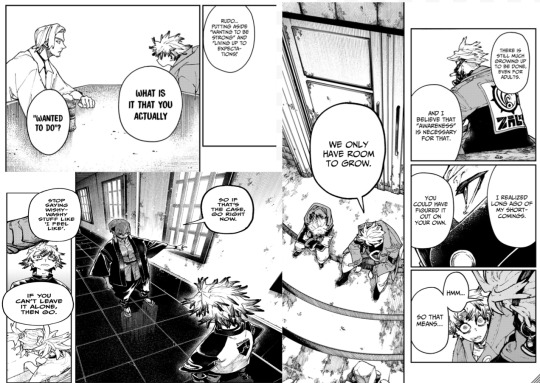
Not in a sort of guidance counselor way, but more in a natural way of trying to make this kid who has had a life where he hasn’t had to properly think about/experience certain things life can throw at you and they want him to improve. From telling him it's okay to not know what he wants to do in the future, to letting him know it's okay to make mistakes, to learning how to properly have a conversation and connect with others. I think a lot of these moments can feel like sweet nothings, but for me I saw it as a part of growing up. Or rather something I wanted growing up. I’ve experienced many moments of my life where I felt lost not in small part to the fact it felt like no one could meet me on my ground. And something about Gachiakuta is the attempt that almost every character has made trying to reach Rudo and show him a form of empathy. And as the series has gone on that empathy has really changed. He went from a kid not understanding what was wrong about saying “I'm only working with you till fulfill my goal!,” demanding cooperation from others, to actively trying to ask for help when hears of an opportunity to come closer to his goal.

This sort of vulnerability I think was present in his moment screaming his revenge. He’s visibly crying. Despite all the bluster and crassness, there’s clearly a frustrated and overwhelmed boy who has been condemned by a society that brands him “unclean.” This is also where I should mention Urana is an absolute master with art and expressions. Making everyone feel so alive. Rudo’s faces are an absolute highlight. Despite a person who seems set up to have a chip on his shoulder, he may be one of the wackiest in just how big he can let his emotions go. Which ties into our next part.
Zodyl and the Watchman Series
Now I'm sure you’re wondering, “Arkus, you said that this manga hasn’t hard confirmed Rudo is actually neurodivergent, yet you say the text makes the analogy so does someone finally say it?” Well to answer that, I’m gonna need to talk about the main villain of this series and the tools he’s after, The Watchman series.

Our seemingly main antagonist of the series is a man named Zodyl Typhon, leader of the organization The Raiders (Or the Vandals depending on the translation) a group of evil givers who seem to be devoted to the destruction of The Sphere. As they living in a world where the natural order is simply that they are a people who have garbage raining down upon them. Polluting them, crushing them, and people of the Abyss have gradually become accustomed to it all. Zodyl wants to shock the system and he wishes to get his hands on all the various powerful Jink known as the “Watchman series.” So far it's known that only Rudo’s gloves, Amo’s boots, and Zodyl’s coat are part of this set.
Zodyl is depicted as an amoral, somewhat sociopathic person, with intense eyes, viewing people as experiments to test his theories, and showing practically no emotion. He describes each piece of the Watchman series as containing extremely powerful emotions in them. A normal person couldn’t use these items with going mad due to these emotions. Yet people like Rudo and Zodyl haven't gone mad. Well that’s being they’re not like others.
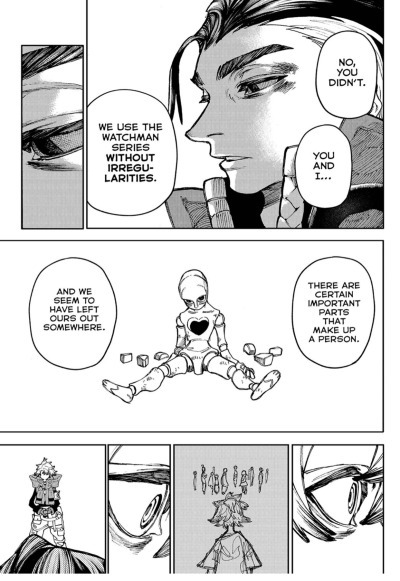
In one of the most painful visual analogies, Zodyl describes that in this world there are people born missing pieces that every other human is born with. This leaves them as something sort of empty. WIth Rudo knowing exactly what he’s talking about. This was already hinted at by Amo who says wearing her Watchman boots feels as though she’s a toy that had a new battery inside. Zodyl doesn’t think that missing something fundamental is a bad thing though, in his opinion not being born with it has made him a vessel for this power.

I once again cannot say with a hundred percent certainty that Kei Urana was intentionally channeling the experiences of those who may be told “they’re not like others because they were born atypical” but it's so hard for me to not read it that way. Especially the part where Zodyl rejects the idea that there’s anything wrong with this. He’s not wrong for how he’s born, look at all the cool stuff he can do now. While Rudo stands there and thinks about how isolated he felt from everyone else. It's easy to see these as two very valid responses to someone with a mental health diagnosis, lamenting how this puts you at odds with others and how being different in this way makes it harder for you to connect. While the other rejects needing the validation of others, there isn’t a problem.
Once again, no one just flat out says it, but so much of the subtext is basically there in your face in regards to Watchman and Zodyl’s speech. But the fact this power is only wielded by something that is described as a missing piece. With the image of a heart in pieces. To me, the emphasis placed on the value of one’s emotional and mental capacity as something that can be filled, like its just so out there how can I not see something there?
Well maybe its because I want to?
Artistic Interpretation
Look, I'm not gonna to give you a dry lecture on the value of artistic interpretation. I think we’re all mature enough that multiple people can have multiple different interpretations of a single world. With art being something that lends itself to being read in a variety of ways. I'm not making this post to delegitimize any interpretation.
Rather I wanted to come all the way back to the pin I put in when mentioning the unconventional story structures. Now it should come to no one’s surprise that the woman who was an assistant and student of the guy who made Soul Eater makes some bizarre choices. Not the least of which being the characters and tone.
No, rather I wanna touch on something that I find Urana and Okubo do better than a lot of people which is visual interpretation. Both utilize the visual aspect of this visual medium to make some points. But rather, both of them allow these visuals to hang out there and allow you the reader to come to your own interpretation of this.
This type of storytelling in my opinion can force the audience to actually engage with the work in a deeper meaningful way. While some would argue that it leaves things open in a way that may never truly be satisfying. I think in the case of Gachiakuta it has less of that tha an Okubo work, but there are plenty of things I do believe Urana leaves out there for you to read as you will.
When I see her going out of her way to make a doll with their heart missing and a man describing a feeling of them missing, Uruana is not expressly saying anything, but allowing us the audience to decide how we read it. I'm certain she has her own way of viewing this story, but I do appreciate that she’s allowed Gachiakuta to be a series where we are allowed some creative liberties. Especially in the fact this is a weekly shonen manga. A demographic I feel often can suffer from needing to make everything somewhat obvious in its meaning or intent.
But Urana really knows how to capture this sort of vibe. Allow the art to speak for itself and I find myself having to put some of myself in the series when I read and interact with it. So while I’m sure there will be people who think I have basically convinced them of nothing and that this might all be reading to deep, I do at least want to point out that Urana herself has at least allowed for me to make these connections on my own and I think that is worth something at least on her part as a creative.
Conclusion
So yeah what was that all about? Welp like I said this was to be a more personal thinkpiece. One where I wanted to work through my own feelings on why this series had me captivated. Also it's possibly my attempt to broaden the discussion of Gachiakuta.
Despite the fact many have made the prediction its gonna be a “big deal” it really isn’t. At least by pure sales wise. Nothing bad, but nothing remarkable at the time of writing this. Honestly its doing much better than a series that’s not on the extremely accessible SJ app. It’s a good series but it may just always be underground.
Every influencer wants to be on the ground floor, whether it's this, Red Hood, Kagurabachi, Nue’s Exorcist, Astro Royale, Mama Yuyu, Centuria, etc. I get that hype and memes are a powerful thing in this internet consumer world. But I do want a series that may be big or important one day to touch on things that make it good beyond hype and anticipation.
And for me that is what I got with Gachiakuta. There’s an element to it that I haven’t really felt in manga in other media. And the fact it could make me feel that… that’s special to me. I know I’ve talked about some heavy topics and I do hope I was as respectful as I possibly could be. Opening up like this was hard for me.
As I do truly love this series and hoped I could illustrate why it resonated with me, perhaps it resonated with a lot of people who can see themselves in this one trashy boy.
I hope everyone reading can have that sort of character they see themselves in, and if you enjoyed please like or reblog as it tells me you'd be interested in reading more
#discussion#manga#anime#gachiakuta#rudo#rudo surebrec#zodyl typhon#gachiakuta zodyl#autism#neurodivergent#interpretation#black clover#sousou no frieren#frieren: beyond journey's end#fern frieren#frieren#rill boismortier
16 notes
·
View notes
Text
Nevermind you lost the FE fans



Well looks like Re:Fantazio has the three houses fans
10 notes
·
View notes
Text


Well looks like Re:Fantazio has the three houses fans
10 notes
·
View notes
Text
Are We Returning To 2000s Era Shonen Anime/Manga (A Discussion)
So this is going to be way more of a thinkpiece than I usually do for this blog, but recent trends in the space and niche that I devote a lot of time to, Anime/Manga, have been showing themselves that got me thinking. This is not meant to be a serious sociology case study taken as fact, it's going to be more a theory based on observations of the community that I, like many others, devote a lot of time into than a full on claim, but I do want to ask, is the anime and manga community is experiencing a resurgence in 2000s era shonen manga?
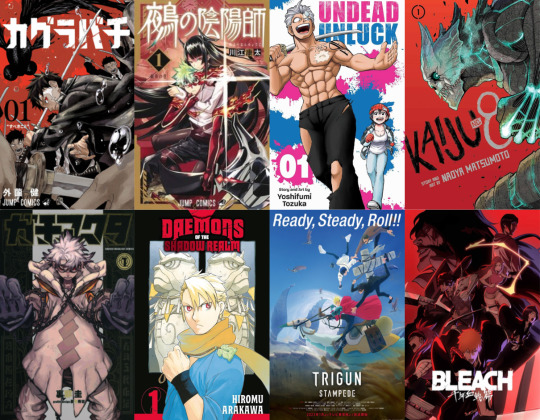
Background
Now let me get this out of the way, there is bias in these observations as I am a western anime fan, but also a North American anime fan. Meaning my gateway and gauges of pop culture are mostly determined by the history of my area of the world’s relationship with anime. From the OVAs of 80s hyper violent and hyper sexual sci fi that you had to purchase from the backs of video rental stores, to the Toonami era of 90s and early 00s programming block the centred around action anime and cartoons, the 4kids era of mass market japanese animated kids shows that were really just giant commercials with some of the earliest memetics in western sphere, and the explosion of shonen battle series in the western sphere in the mid to late 2000s marked by the rise of the colloquially named “Big 3” of shonen jump.
I understand that continents like South America or Europe may have undergone a different exposure to the Japanese medium, but as I am going in with some bias in this observation, I would like to make it clear on where the formula is coming from.
I also would like to lay down a certain clarification before making this, when discussing the topic of nostalgia I think a lot of people have forgotten what it actually means. If we go by the Cambridge dictionary definition, Nostalgia is “a feeling of pleasure and also slight sadness when you think about things that happened in the past.” This is often invoked when talking about pop culture because people from say 20 years ago don’t seem to enjoy or relate to the interests of today. The belief is that nostalgia is generational ergo if you grew up in the 80s you’re likely wishing to recapture the feelings of childhood that you associate with those trends from 20 years ago. In fact, most revaluation in media has often been catalyzed by a difference of those who grew up in an era rebuffing the opinions of those who didn’t.
There is the well known “20 Year Rule” regarding pop culture nostalgia. That every decade it longs for what was popular 20 years ago. Probably no better example than “That 70s show” being popular in the late 90s, the return of many beloved 80s-90s franchises like “Ghostbusters” returning in the 2010s as well as series like “Stranger Things” that wrapped itself up in 80s aesthetics. DC's New 52 relaunch that seemed to bring back trends from 90s era comics.
Now it goes without saying that the 20 year rule isn’t a “real” rule, rather an observation that certain trends make a return to popularity because the ones who grew up with a certain media will be the ones who add to the discourse when they come of age and will be the ones having a chance to create consumable art for the masses and that may just be revivals of once popular IP. This isn’t necessarily wrong in regards to nostalgia, but I do believe that one doesn’t need to have been born in a certain era to be nostalgic for something when we discuss pop culture. Pop culture is really just trends and preferences that become en vogue and people can acquire a taste at any given time. Sometimes it can be due to those who grew up with something now having the chance to create and drawing upon their own childhoods, sometimes it's just due to not being exposed, other times it can be a certain feeling of disillusionment of the now, and seeking something that peaks your interest, and even sometimes it can be major corporations or networks looking for things with existing audiences to draw upon that actually expand the audience. In fact one of the most prominent Netflix adaptations of the 2020s has been live Action Avatar the Last Airbender and One Piece, both shows that got their start on American televisions in 2004 and 2005. One of the biggest animated shows right now is Invincible, based on a comic book from 2003
So I want to stress this is not necessarily about how if you grew up with the original Mobile Suit Gundam show you are being replaced by the kids who were watching GetBackers. And or if you are a fan of shows that came out in the 2000s you yourself were born in the 2000s.
But what was the landscape of the English speaking anime community like back in the 2000s? Well let me paint a portrait for you.
What was the 2000s like for anime fans?
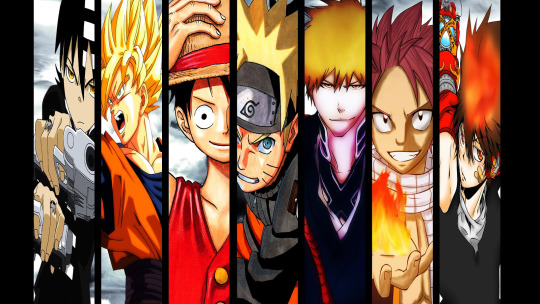
The term I used, “shonen boom period”, is somewhat mythologized in the western anime sphere. There was a glut of high profile shonen anime running around the same time that most people identified with this time period and was arguably when we saw the most influx of people getting into the hobby. One Piece, Naruto, and Bleach served as big series known for their massively large casts, MCs with a level of attitude, some of the most hype centric power supernatural/extraordinary power systems, and certain brand of “Japanese-y” humor.
We can’t deny that it wasn’t just these series however, as series like Fullmetal Alchemist became many people’s introduction to more narratively intricate series interspersed with a somewhat gothic action style. The gothic and somewhat edgy Death Note became many fans' first ever “battle series that’s not a battle series” that also incorporated many biblical and gothic horror elements into its presentation. And things like Code Geass also incorporated this combination of hyper stylized cat and mouse with ornate and gothic aesthetics and fighting robots.
Series like Ouran Highschool Host Club and and Haruhi Suzumiya were basically gateways to the more hyper extraordinary slice of life series that didn’t shy away from fanservice and loud comedy. With ecchi like Rosario + Vampire taking it to an even greater extreme. For people willing to go even deeper, series like Fairy Tail began to pop up and share a distinct similar flavor to series like One Piece and Naruto which arguably started the popular conception of it coming from the same magazine as the latter. That’s not also discounting the amount of holdovers from the 90s like Dragon Ball z, Trigun, and Yu Yu Hakusho, which also had an edge towards fantastical combat and comedic oriented series.
All of this is to generally illustrate the media diet of what an average anime fan was expected to have some level of access to. As this was far before the eras of Funimation or Hulu having online services. Not a homogenized spread by any means, and im certain plenty of readers could name more underground or smaller series like Mushishi or Elphen Lied, but generally the popular mainstream you could tell that there was a consistent theme of long form media with a very loud, very flashy, and very action oriented type of series. Which I think is fair to say had skewed some people’s perception. And while I cannot claim with utter certainty that Japan was the same in this regard, you can look at magazines like Shonen Jump and notice a somewhat synchronistic trend. With series like Hitman Reborn, Gintama, D. Gray Man, Eyeshield 21, Bobobobo, etc.making a clear marcation of what was commercially successful at the time.
Even series not inside the magazine but had smaller nicher, Tokyo-pop-esque series like Rave Master, Flame of Recca, Air Gear, History’s Strongest Disciple Kenichi, Soul Eater, etc all had a similarity to the shonen jump magazine. To the point it was not uncommon to see so many jump characters in a collage and one from shonen sunday or shonen magazine in there as if this was all coming from the same place.

Changing Landscape
Now with the advantages of the modern internet, we have the ability to actually keep up with the jump magazine in real time as opposed to the common practice of relying on scanlation site and fansubs that were often devoted to the most popular works. But with simultaneous publication and services like Crunchyroll, being able to access a wider variety of shows and series that we may or may not have access to. I believe that the 2010s in the english speaking fanbase was the decade we saw a somewhat expansionism of what people perceived as anime. Anime could be One Piece and Naruto, but it could also be Erased, it could be the Promised Neverland, Attack on Titan, K-On, Haikuu, and Durarara. With the representatives of the 90s no longer being holdovers in syndication like dragon ball but rather full on revivals of the likes of Jojo’s Bizarre Adventure and Hunter x Hunter.

All of these could be "shonen" but also other genres like Seinin, Josei, and Shojo all had their own varying layers of what they could be in their demographic
The mood of what was popular was also changing, not just in the fact that more flavors of anime and manga were becoming mainstream, but new works from shonen jump showed a rise in almost subversive series like My Hero Academia and Demon Slayer that seemed to consciously deviate or place new spins from traditional tropes of the 2000s characters, and we saw works that were derivative of previous serious like Black Clover drawing upon Naruto the same way it was known that Naruto had drawn upon Dragon Ball before them. Series like The Promised Neverland and Doctor Stone offered up more dramatic series that still infused a certain energy of the shonen genre.
And of course the series like Attack Titan whose much more darker and gorey storytelling seemed to have become one of if not the biggest hit of the generation with a well regarded adaptation, but something that had felt so removed from what were once contemporaries like the then ending Bleach or Naruto. We can also note that the late 2010s saw the rise of series like Chainsaw Man and Jujutsu Kaisen that began a trend of popular urban fantasy stories. Where fantastical concepts were now in contemporary Japan and the stories that focused on concepts like self identity and the harshness of maturing were juxtaposed to the real world inhabited by monsters.
It seemed many tropes of the previous decade were still alive in the rise of Isekai anime. Which was particularly the only popular outlet for fantasy stories with an action orientation. But these almost felt disconnected from the wider world of manga as things like heavy harem action series had actually decreased in mags like shonen jump. There was also new tropes being established in this subgenre that became unique popularizations of tropes all on their own, such as the overpowered protagonist whose power everyone believes is weak. But many of these were based on light novels, a form of media that only in the last few years western readers are having official access to and not simply scans found on the internet.
We in North America truly have gone from anime being a niche that was primarily accessible through dedicated TV blocks like Toonami, to a full blown cultural relevance shift.
We also need to talk about this era in its perception of the past also shifted. The 90s and the early 00s often blend together as classics of the anime community. Somewhat encased in amber. However, there is no denying that “feels like a 2000s series” had become a bit of a shorthand for very goofy, Very horny, very action heavy series. Series like Fire Force and and Undead Unluck had their show what more problematic elements be equated to the problematic trends of the past that people just accepted as “a part of the medium.” But lets keep in mind, this is not really describing a time, more a trend. Superficial elements that invoke similar feelings of the past.
Speaking of anime fans…
Fan Culture
So while I wanted to paint a picture of creatively the landscape has changed, there’s no denying that in the age of internet accessibility, the anime fan community has also changed. It is much much easier now to get in contact with people who are anime fans now than it was to rely on word of mouth like it was back in the day. I can still distinctly remember my anime club which wasn’t even really a club devoted to anime but rather other geek stuff like D&D and TCGs. Our hobbies just happened to have similar overlap.
Now though, anime fan culture is much more relevant and thriving. Going from just posting weekly reviews, to long retrospectives, comedy videos, abridged series, clickbait articles, fan theories, and podcasts. However, I think a defining feature of fans of the 2000s era of anime that were at their most prominent was hype culture.
Due to many of the biggest anime series at the time being released weekly and focusing on action, many many many discussion boards and videos were often about staying in this cycle of wanting to see what happens next and the action made people very excited to see just how characters were going to win fights or even if they’d have fights at all.
I want to make it clear that this type of activity doesn’t belong to a certain era, but you can see it shaped by the 2000s era. Especially when discussing “what is the next big 3.” As if it were a true position and title, rather than a moment in time where there were just three very distinct shonen series in the fanbase.This doesn’t necessarily have a “negative” effect on the discussion of anime/manga but you can see that certain genres lend themselves to hyping fans up more and more.
Someone isn’t reading the most recent chapter of a romance like Blue Box with the same level of anticipation of who will face who like it was One Piece. But there have certainly been series that try.
The Present
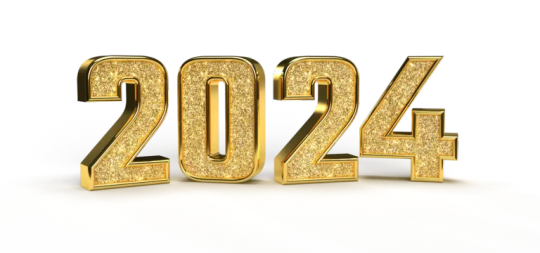
Now we reach the 2020s and this decade is still young, so it is hard to say what the future will hold for certainty, but we can look at the last four years and notice some significant waves being made recently in Shonen Jump alone. I already spoke of Undead Unluck, a series that almost wears it would now be considered retro inspirations on its sleeve. With an opening chapter that establishes an MC that seems motivated by a sexual joke, A power system follows a verbal naming gimmick, and a loose enough world that allows for characters of varying aesthetics and to be incorporated into groups. With groups of these powerful characters splitting up to face each other and use their ridiculous power to the extreme. Even in the series' own meta arc about creating manga, the in-universe analogy for Undead Unluck’s manga is commented on as feeling retro.
There is no doubt the biggest viral hit of the decade so far has gone to Kagurabachi, a manga about sword fighting and magical crime lords that seems almost indulgent in its stylistic slicing and or dicing of baddies. Its memetic success was primarily due to a somewhat sincere and somewhat ironic belief that it would be the “next big thing” as it promised to be a stylized action series. Another surprise viral success has been the manga Nue’s Exorcist which sees another supernatural swordfighter boy harness the powers of his sexy spirit lady while getting into harem shenanigans that echo a particular form of ecchi of anime’s past that had actually been somewhat absent in the past decade in jump. Both of these series have a somewhat noticeable similarities to Bleach, a long running shonen action series that has seen its own revival in the last few years of writing this with the long awaited adaptation of the final arc of the bleach anime.
While the other members of the “big 3” never truly went away and became almost inter-generational, Bleach truly did feel like a “come back” as it was absent for so long. And unlike Hunter x Hunter and Jojo which were never really popular in the west and even their older anime are more regarded as anime deep lore. Bleach was one of the most popular series in the west at the time to never receive a conclusion animated.
Speaking of anime of the 2000s Trigun Stampede was a reimagining of the original late 90s show. This errs a bit similar to Hunter x Hunter’s style of revival, but also seems uniquely its own in actually trying to find a balance between the original series but adding in things cut from its original late 90s early 2000s counterpart.
And now we must examine other shonen magazines. Series like Gachiakuta created by a former assistant of Okubo, the creator of Soul Eater, carries with it much of the similar energies of that series. Its also noticeable as being a truly dark fantasy series. Not an urban fantasy, but rather a completely new world that had a very grunge and dirty world building. And then there is Daemons of the Shadow Realm, a series by Fullmetal Alchemist creator Hiromu Arakawa. This series is also set in modern day japan with supernatural elements, however Arakawa’s style of writing is practically unchanged from her time on FMA. With an emphasis on action, intricate mysteries, and character building comedy with her trademark over exaggerated blocky style. There is of course Hiro Mashima who has started another new series, Dead Rock, and his style has also not changed that much. Then there is just flat out sequels to 2000s series like Gamaran Shura.
This to me shows that we are seeing a bit of a combination of people who are now entering the workforce inspired by creators of the past, but also that creators of the past still exist 20 years later and are still making content that hasn’t really undergone significant change.
Of course, we can’t also forget the implementation of the Manga Plus/J plus service which has opened up a very interesting ground for creators to have some of the most creatively out there series than what you may have expected from the shonen jump brand. I genuinely don’t think series like Make the Exorcist Fall in Love or Fire Punch would’ve ever been acceptable in the pages of a weekly shonen series. However one series in particular does feel like it could've and boy its been quite the success. Kaiju no 8.
Kaiju no 8 almost feels as though it is the AoT of a new generation with the amount of anticipation this one series has as well as the similarities between the series superficial elements. However, I'd say the key distinction between the two has been the tone. AoT took a dark and practically dour tone on its titan infested world. With an MC declaring war on all of his enemies. The pain was realistic, with human bodies being brittle and vulnerable. And the belief that just because you were a good person you weren't going to make it out alive. Kaiju no 8 instead opts for a more action oriented tone. Down playing the bleak realism for more "Hell yeah!" moments. With super science weapons that feel more akin to a tokusatsu show and fights and battles between humans an kanji the feel like the Dragon Ball style wrestling matches of old.
And of course, that’s not to say Jump hasn’t continued with series that feel more modern like the realistic and mellow romance of Blue Box or the dramatic coming of age story of Akane-Banashi.
But the presence of these series has caused somewhat of a friction with the popular conception of the magazine. Its safe to say that while “shonen” tends to think of action male oriented series, it can really just mean works aimed more at adolescents. But I think many tend to associate this familiar feeling of “what is shonen” with their popular introduction of the magazine. With a saturation of action and brash comedy series. This is further complicated by the fact many action series in jump are actually ending over the last decade. With new ones not popping up to replace them as frequently and series like One Piece and MHA and Black Clover basically stretching out across an entire decade or longer.
In fact, I don’t think it's unreasonable to believe that the hype for something like Kagurabachi was in part a belief that it signaled a return of a type of familiar series and genre that had been missing. Or at the very least, looked to fill an inevitable gap the magazine was obviously going to be facing. Followed by the other commercial success of Nue’s Exorcist, we are likely to see these series last for a long time. At the time of this writing, Tokyo Revenger’s author Ken Wakui has released Astro Royale, a series that feels very similar to his previous work yet infused with this almost GetBackers flavor.
So that leaves us with the question at the start, are we seeing a rise in 2000s nostalgia in anime and manga?
Conclusion
So I'm sorry if I disappoint, but the best I can say is, I’m not certain. I do believe that from my observation I think it is reasonable to say that we are seeing a rise in creators in the shonen space being ones inspired by series from 20 years ago. However, I think we are also seeing creators who are from that time period also returning to write how they have always written.
On the consumer side, I think we can see that fans of anime and manga have changed in the sense their tastes can now be shaped by a much larger catalog of series at their disposal. But in the case of shonen, I think we are simply seeing those who likely got their start in anime at around the 2000s resonating with newer series drawing upon those series, but also with younger fans now likely to grow up with the tail end of what was popular in the 2010s now being influenced by the 2020s.
I also believe that one of the defining features of the anime community in the last decade is hype culture. And currently we are seeing a rise in series that actually feel more catered to hype, be it a revival of a series they liked or predicting what will be the next success.
All and all, this piece was trying to tunnel on the shonen demographic in general, which is more likely than not going to have similar traits relative to itself. I do see us as a community endorsing trends of the past and there’s an excitement for these things to “come back” even if they may or may not have left.
If you liked this please drop a like or reblog because I may do more of these think pieces in the future.
#anime#manga#think piece#discussion#shonen#shonen jump#kagurabachi#gachiakuta#nue's exorcist#undead unluck#kaiju no. 8#bleach#one piece#naruto#yomi no tsugai#attack on titan
44 notes
·
View notes
Text
the Federation itself as a concept is so funny because the founding members are
the Vulcans, who have been friends with humanity for years but don't seem to actually like them all that much, instead regarding them with a sort of perverse fascination usually reserved for virology labs
the Andorians, who were fighting the Vulcans for like a hundred years
the Tellarites, who don't like any of these people and whose cultural trait is arguing, and
humans, whom nobody knew existed until last century when they shot themselves into space on a heavily modified nuke, invented world peace and won a fight with the nearest imperial superpower
like imagine you're the Romulan Empire and these weird monkeys who've barely figured out interstellar travel show up on your doorstep in the equivalent of a shipping container with missiles strapped to it, kick your ass in front of everybody, and then start a friendship club with 3 of your neighbours who all hated each others' guts until like a year ago. now I understand why every Romulan on the show is so angry
24K notes
·
View notes
Text
So this is heavy but recently shared, Akira Toriyama, legendary mangaka and creator of Dragon Ball has passed away today at age 68.

I know I am one of many when I say Akira Toriyama’s works were inspirational. The man’s incredibly legacy and influence on the tropes and style of manga we take for granted these days is practically unfathomable. From creators of all walks of life, professions and backgrounds.
He is an indisputable legend of the medium and inspirer of many. Thank you, Toriyama. Thank you and goodbye. May you rest in peace


521 notes
·
View notes
Text
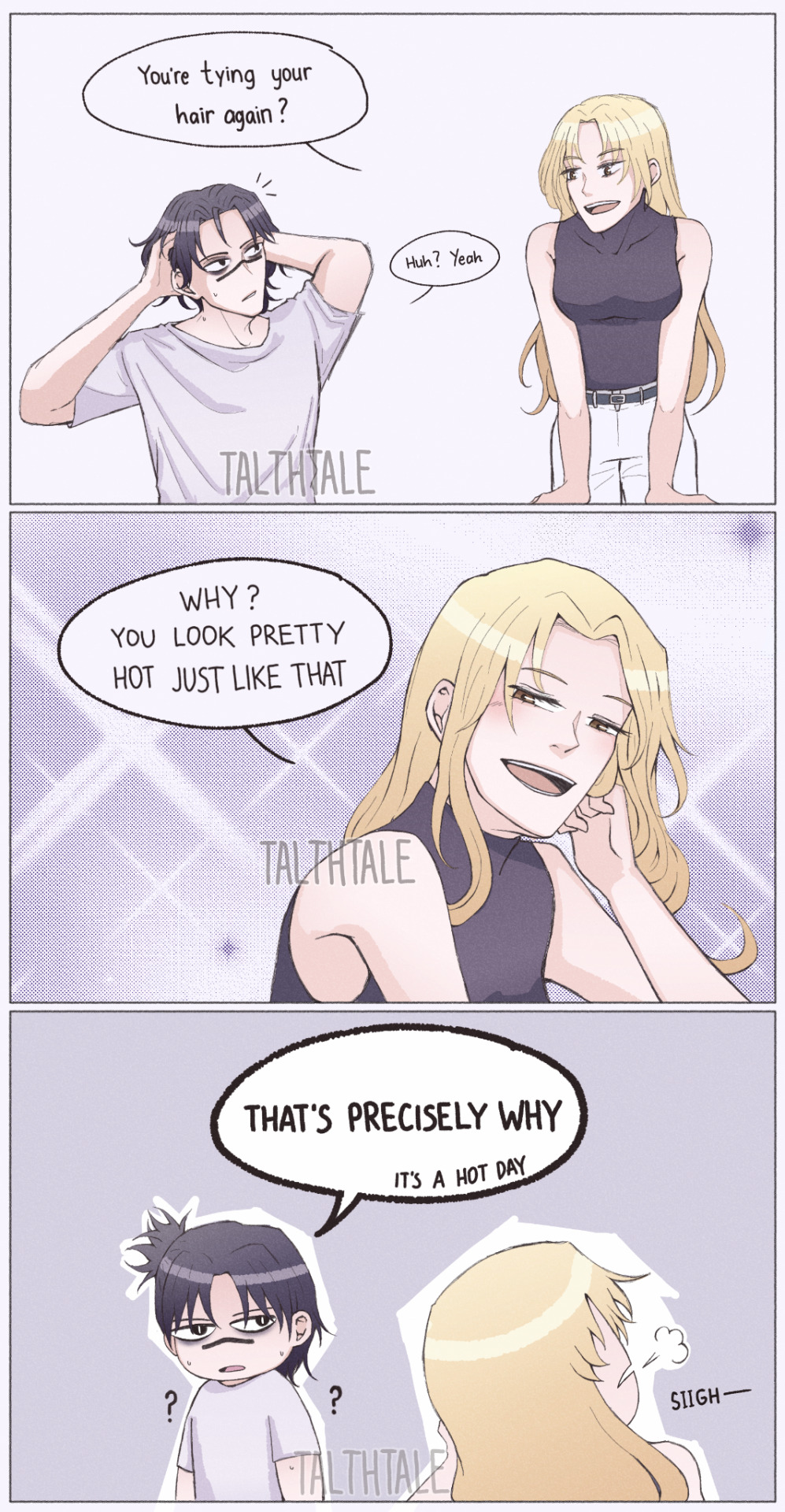
Later that day:

My guy finally learned a lesson:

3K notes
·
View notes
Text
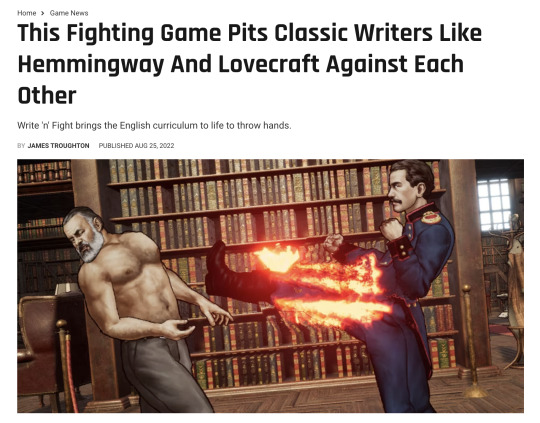
furious that i am not a playable character in this game
71K notes
·
View notes
Text
We got his name? Holy cow! The main character of Gachiakuta is Rudo Surebrec!

39 notes
·
View notes
Text
“I want to play a MegaTen game with an emphasis on characters and mood like Persona, but also star more mature characters and subjects like SMT. And it can’t be as simple as Soul Hackers.”
Have you heard of a game called Digital Devil Saga?

Not putting down people who like either: DDS just has like the best mix of Persona/SMT imo. It’s got the dark existentialist world of an SMT game but the style and character arcs of a Persona game.
Heck, everyone has a unique demon with the Atma Avatar system similar to Personas


It’s biggest failing in my opinion is that it really is one big story/game split between two parts and you really need to play both to get closure.
11 notes
·
View notes
Text
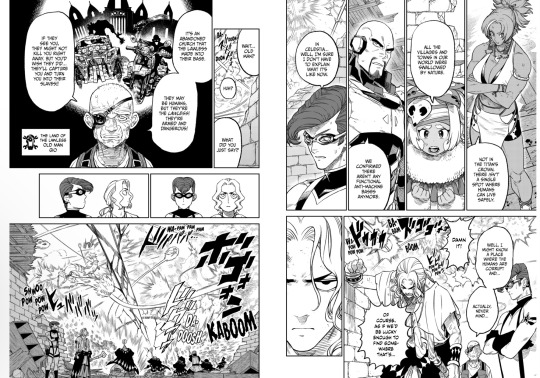
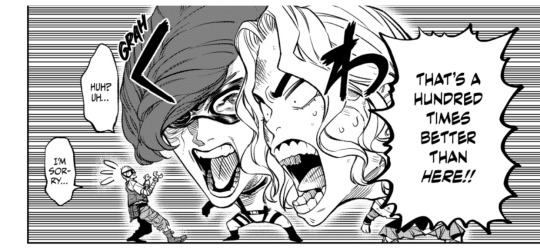
About time someone finally brought up the obvious in Versus
2 notes
·
View notes
Text
Ryoji: Hello, all my fellow students
Minato: Okay, you’re Pharos. You literally have my face.
Yukari: He is kinda cute.
Minato: He is literally me with my hair combed back! He has my voice too!
Junpei: Man I feel like I already know Ryoji.
Minato: Gaaah!
39 notes
·
View notes
Text
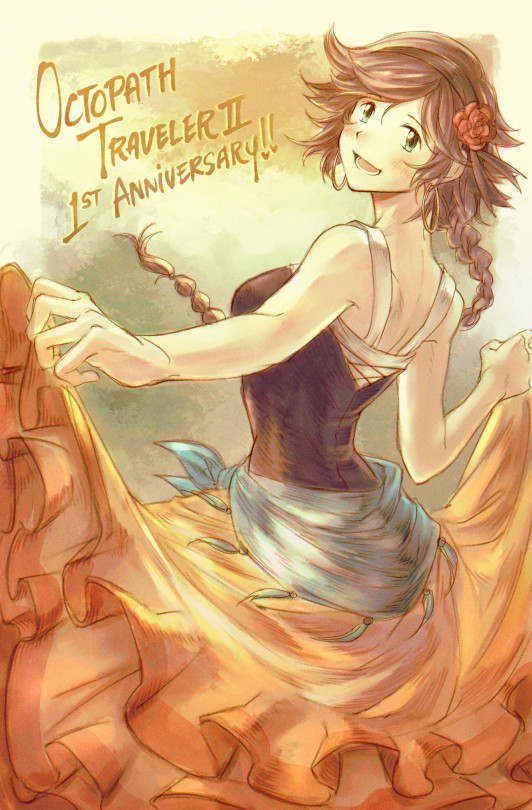
Happy 1st Anniversary Octopath Traveler 2!🐙💃🌟
Thank you for such an absolutely amazing game 🥹💖✨
366 notes
·
View notes
Text
Takaya: I shall deliver onto you SALVATION!
Shinji: Oh no! Amada! He has a gun! A real gun!
Ken: Oh no, that makes him literally the most dangerous person in the persona franchise!
27 notes
·
View notes
Text
Manga Recommendation: Tower Dungeon
So looks like Arkus Rhapsode is here to recommend another fantasy manga after the last one. So this time we're going for a bit of a different flavor with the series Tower Dungeon by by Tsutomu Nihei who you may know as the creator of Blame! and Knights of Sidonia.
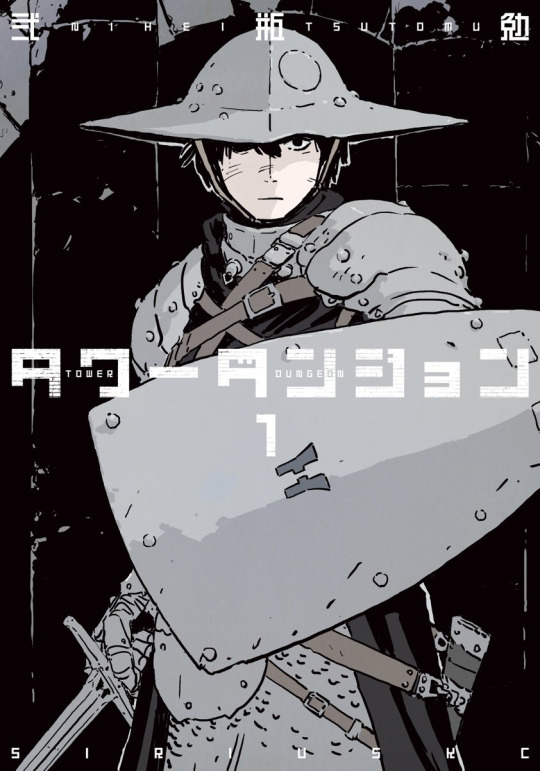
Now I've known about this series for a bit even though it is relatively new. Having only started last year in Monthly Shonen Sirius. But I remember its announcement from people like Manga Mogul and hearing Makoto Yukimura (Author of the incredible Vinland Saga) recommending it. Now I always loved Sword and sorcery so I was gonna read it eventually, but it just wasn't translated. However, now being able to read the available chapters, I can say this is a very different type of fantasy series.
The premise is very basic: An evil sorcerer has killed a nation's king and kidnapped a Princess and now the royal knights need to ascend the "Dragon Tower" to save her. One battalion has conscripted a young man named Yuva for assisting troops medically has found he has impressive strength. Now Yuva must strengthen himself for the journey ahead as they explore the deadly tower.
Now like all simple premise stories, the real strength is in execution. And unlike the other fantasy series I've talked about before which have bucked the trend of "RPG fantasy" be leaning more into a traditionalist fantasy stories a la Tolkien, this goes for the more realist fantasy of something like Berserk or Dark Souls.
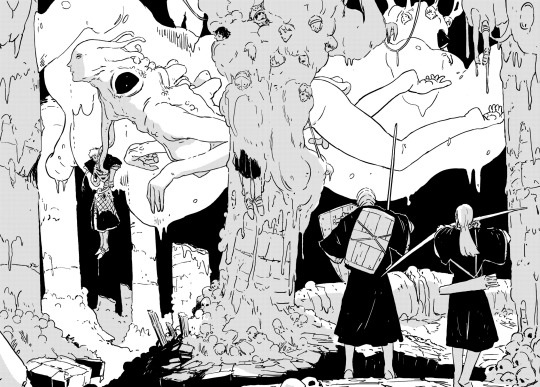
The world of Tower Dungeon may have things like magic and dragons, but it is a dingy, dirty, and lacks any frills. Knights wear heavy armor and people are covered in blood and scars from their adventures.


The mighty Dragon Tower itself? The most iconic thing about this series and the basis of the adventure? Looks like this. This isn't an opulent tower, this is a massive imposing structure where monsters dwell.
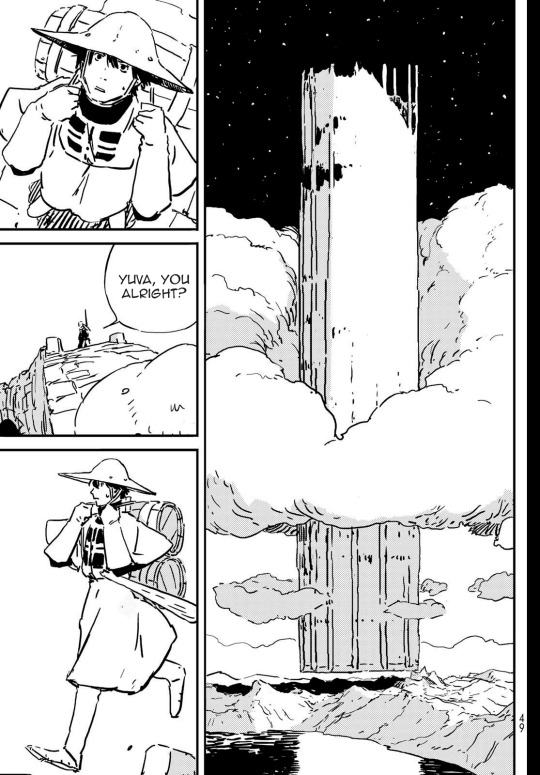
However, unlike some grim dark or edgy fantasies, this world isn't indulgent in its darkness. The violence and death are never cool or cheap. They are simply the way the world is. Even when magic exists, the world is still like Medieval Europe and all the "joys" that come from it.
The people as well are similar. These aren't romanticized or polished fantasy archetypes that often come with the idea of a Dungeons and Dragons style adventure, these feel like average joes plucked off the streets having to do a job. If you are say a fan of something like Chainsaw Man, this sort of post modern emphasis on people acting like regular weirdos and not some "anime characters." And I think that is something quite nice that even in a fantastical world, we can see our regular selves in them.
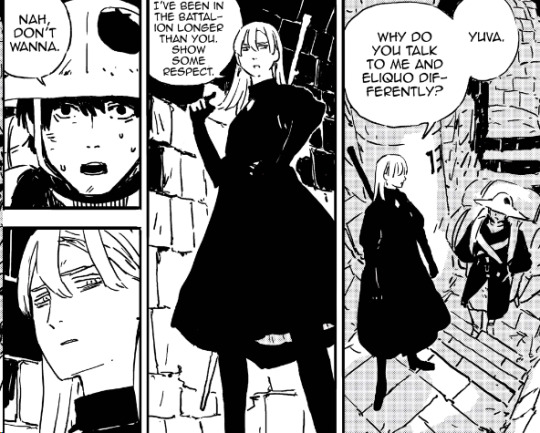



But that's just the story, what about the art? Well if you've noticed this series does have a very minimalist style. Something similar to that of Land of the Lustrous or Chainsaw Man. These almost scratchy and not the most detailed designs that make use of their simplicity to create this very unique atmosphere.




Creature designs themselves are less fantastical and more grody. Feeling as if they come from an off shoot of man rather than some majestic beast. Right down to the cat people.


This series is still new and sadly hasn't been officially translated yet. I've had to use mangadex to read this, so my heart goes out to the translator team. I can understand that this may be a niche that's not for everyone, but its something that feels like such a good sign for fantasy as a genre. A genre that I think has somewhat been stagnated in popular belief with the greater emphasis on Urban Action manga and the reliance on escapist fantasy anime like isekai. To see a more dirty but down to earth take on the premise, I highly recommend it.
#manga#manga recommendation#recommendation#tower dungeon#tsutomu nihei#nihei tsutomu#blame!#shonen sirius#chainsaw man#dark souls#knights of sidonia
31 notes
·
View notes
Text
I remember when the only thing I had to worry about with an anime adaptation was hoping for a studio with a good, proven track record was doing the adaptation. But now its also worrying about that AND hoping that they don't end up a Disney+ or X streaming exclusive.
50 notes
·
View notes
